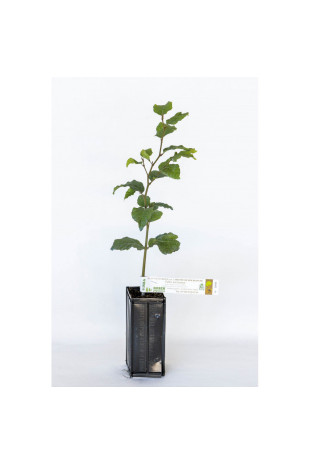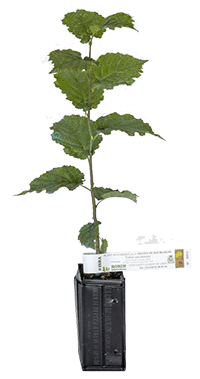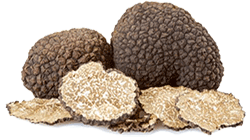


 Young truffle hazelnut plant (Corylus avellana) mycorhized with tuber aestivum. Hazelnut intended for the production of summer truffles. Truffle hazelnut plant aged from 1 to 3 years, produced in France with certified quality under INRAE control.
Young truffle hazelnut plant (Corylus avellana) mycorhized with tuber aestivum. Hazelnut intended for the production of summer truffles. Truffle hazelnut plant aged from 1 to 3 years, produced in France with certified quality under INRAE control.
You want to grow summer truffles and are looking for the best plants for this production? Or perhaps you simply want to add new plants to your truffle orchard that will produce the famous St. John's Day truffle, harvested in the summer and appreciated for its fine and subtle aromas? Thanks to its excellent truffle-growing abilities, the common hazelnut tree could well satisfy your needs and appear as the adequate truffle plant to support and increase the production of your truffle orchard !
 This common hazel truffle plant is obtained after controlled and certified mycorrhization of a common hazel tree (Corylus avellana) with summer truffle spores (Tuber aestivum). The tree obtained is ready to be planted in your truffle field. It will produce its first truffles within 4 to 5 years.
This common hazel truffle plant is obtained after controlled and certified mycorrhization of a common hazel tree (Corylus avellana) with summer truffle spores (Tuber aestivum). The tree obtained is ready to be planted in your truffle field. It will produce its first truffles within 4 to 5 years.
In order to meet your expectations, our common hazel truffle plants, mycorhized with the summer truffle, are available in 4 sizes of cups:
- in anti-chignon® R430 cup of 0.43 liters
- in anti-chignon® R600 cup of 0.6 liters
- in anti-chignon® R1.5L cup of 1.5 liters
- in R3L container (volume of 3 liters)
Hardy (up to -25°C) and very vigorous, the common hazelnut (Corylus avellana) is an excellent truffle plant as long as it is planted in a very calcareous soil (pH higher than 7.5) and well drained to avoid excess humidity. It can grow in almost all climates, but is particularly suited to dry regions where rain is rare, except in the Mediterranean basin. A fast-growing perennial shrub, the common hazelnut tree can easily establish itself up to the mountains (1700 m) on well exposed slopes (sun to half-shade). Its only requirement is its liveliness, which requires regular pruning (every 2 to 3 years) to ensure good light between the branches. Finally, let us note that the hazelnut tree has the advantage of producing a double harvest. It is indeed the only fruit and truffle plant since it produces truffles in addition to its nuts.
 With its fine, subtle aromas, this variety of truffle knows how to conquer the palate of foodies. Called the summer truffle or St. John's truffle, Tuber aestivum grows naturally in many regions, starting with the south of France. It is also widespread in other countries such as Italy, Germany and Greece. Externally, the summer truffle looks like the black truffle. Its peridium is indeed black or brownish. On the inside, however, it offers shades of beige or brown with more or less yellow veins. The summer truffle is best eaten raw and sliced. Indeed, cooking tends to attenuate its fragrance.
With its fine, subtle aromas, this variety of truffle knows how to conquer the palate of foodies. Called the summer truffle or St. John's truffle, Tuber aestivum grows naturally in many regions, starting with the south of France. It is also widespread in other countries such as Italy, Germany and Greece. Externally, the summer truffle looks like the black truffle. Its peridium is indeed black or brownish. On the inside, however, it offers shades of beige or brown with more or less yellow veins. The summer truffle is best eaten raw and sliced. Indeed, cooking tends to attenuate its fragrance.
Our truffle hazel plants are produced in our laboratories under the control and license of INRAE. These plants are then pampered for many months in our nurseries. Quality plants, carefully selected, it is the guarantee to obtain a good yield after only a few years.
 The plants raised in ROBIN ANTI-CHIGNON® buckets are subject to a guarantee of recovery in the event of failure to recover more than 20% of the plants delivered. Under this guarantee, the seller undertakes to replace free of charge the defective plants during the season following the actual observation by the seller of the defective delivered plants.
The plants raised in ROBIN ANTI-CHIGNON® buckets are subject to a guarantee of recovery in the event of failure to recover more than 20% of the plants delivered. Under this guarantee, the seller undertakes to replace free of charge the defective plants during the season following the actual observation by the seller of the defective delivered plants.